-

人教版高中英语必修4Body Language说课稿4篇
Textbook: Senior English for China (Book 4), by Liu Daoyi Time Allotment: 1 period (40 minutes)Date: March 20, 2014Teaching aids: blackboard, Multi-media, Power Point, chalk I. Text Analysis (教材分析)This unit is about body language, and the text selected in the reading part demonstrates the difference and similarity of body language in many parts of the world. Through learning this passage, students are required to raise their awareness of using body language in different parts of the world. As body language is closely related to our daily life, it is easy to arouse students’ interest in learning this text. Reading skills and speaking training are designed around the text.II. Teaching Objectives (教学目标)By the end of the lesson, students will be able to:1. Language Skill Objective(语言技能目标): develop reading ability (skimming and scanning)as well as speaking ability.2. Cultural Knowledge Objective(文化知识目标): know about the cultural differences of using body language.3. Affective Objective(情感目标): increase students’ awareness of using body language correctly in different cultures. III.Teaching Focuses and Difficulties(教学重点和难点)1. Teaching Focuses(教学重点): the difference and similarity of body language in many parts of the world.2. Teaching Difficulties(教学难点): develop students’ reading abilities of skimming and scanning and ask the students to show their opinions with fluent English.

人教版高中英语必修4Women of achievement说课稿4篇
Good morning, distinguished judges:It’s my honor to talk about my teaching ideas with you. Today my topic is Women of Achievement. My presentation consists of six parts: the analysis of teaching material and student, teaching aims, key and difficult points, teaching and studying method, teaching procedures and blackboard design.First, let’s focus on the analysis of teaching material. This lesson is from New Senior English for China Student’s Book 4 Unit 1, the reading part. The main topic of the passage is the introduction of a student of Africanwildlife. After this lesson, the students will learn more information about her studying chimps in Africa, and their reading and speaking abilities can be developed as well.The next part is the analysis of students. My students are in senior high students. They have learnt English for many years, they’ve known many words and sentences, but their speaking and reading abilities are still not very good. So I will practice their speaking and reading abilities through different exercises.According to the New Standard Curriculum and the present situation, I set the teaching aims as follows: firstly, knowledge aims. Students can grasp some new words, such as worthwhile, move off. Moreover, students can understand the content of the passage and get familiar with the topic of studying chimps in wildlife. Secondly, ability aims. Students can use reading strategies such as skimming and scanning in reading process. Thirdly, emotional aims. Students can have the awareness of protecting animals and care about animals.Based on the above analysis, the key point of this lesson is to get the main idea and the detailed information from the passage; the difficult point is to talk about the wildlife protection and use reading strategies.
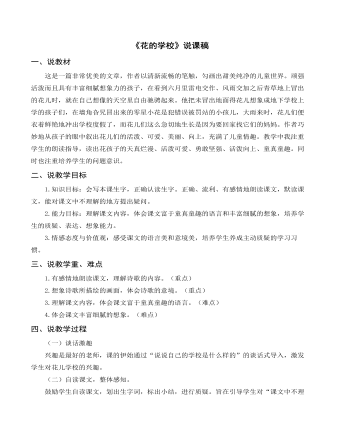
部编人教版三年级上册《花的学校》说课稿
一、说教材这是一篇非常优美的文章,作者以清新流畅的笔触,勾画出甜美纯净的儿童世界。顽强活泼而且具有丰富细腻想象力的孩子,在看到六月里雷电交作、风雨交加之后青草地上冒出的花儿时,就在自己想像的天空里自由驰骋起来。他把未冒出地面得花儿想象成地下学校上学的孩子们,在墙角旮旯冒出来的零星小花是犯错误被罚站的小孩儿,大雨来时,花儿们便衣着鲜艳地冲出学校度假了,而花儿们这么急切地生长是因为要回家找它们的妈妈。作者巧妙地从孩子的眼中叙出花儿们的活泼、可爱、美丽、向上,充满了儿童情趣。教学中我注重学生的朗读指导,读出花孩子的天真烂漫、活泼可爱、勇敢坚强、活泼向上、童真童趣。同时也注重培养学生的问题意识。二、说教学目标1.知识目标:会写本课生字,正确认读生字。正确、流利、有感情地朗读课文,默读课文,能对课文中不理解的地方提出疑问。 2.能力目标:理解课文内容,体会课文富于童真童趣的语言和丰富细腻的想象,培养学生的质疑、表达、想象能力。 3.情感态度与价值观:感受课文的语言美和意境美,培养学生养成主动质疑的学习习惯。

人教版高中英语必修4A taste of English Humor说课稿3篇
Then I would ask them to think of a funny English or Chinese and tell it to partners. While telling stories, they can use expressions and some acting to help make the story funny. 5 minutes would be given to do this.Those stories they told there will be the material for their writing. Soletting them tell it at first is helpful. And they can make a difference between telling a funny story and writing it down. Generally speaking, it is difficult forstudents to write well because they don’t know what to write and how to write. Asking them to tell their own stories at first can help them come up with what to write.After their telling, I would invite someone to share his/her story with all of us and I would write it down on the blackboard.This example story would be used as a sample to illustrate the format of funny story. Different from a story from teacher or textbook, a story from students can obviously become a interesting material to draw students’ attention.Then I would ask the whole class to put this story into several parts. It might be a little bit difficult for them. So I would ask them to find out whether all the sentences are necessary. After delete some sentences, there are 6 sentences left behind. Then they can easily put them into three parts. After interaction with students, I would teach them the right terms for each part and conclude the format of funny story.This step is the key and difficult point in my lesson. So I mainly usetask-based teaching method in this part and the task for students was divided into several stages. With the separated difficult level, students can find there are usually three parts in writing. They can also learn to write without the unnecessary parts in the process of analyzing. And then I wouldn’t rush to tell them the right terms to them directly. Instead, I would ask them to name them by their own. A confused mind is better for acquiring knowledge.While-writing:Then I would give students 7 minutes to write down this story, without other requirements.With all the preparations in pre-writing, students’ difficulties were cleared. So it would be much easier for them to write down the story within 7 minutes. There are no other requirements because students’ first writing is actually a drafting. It would be revise and edit several times later. Writing, as a skill

人教版高中英语必修3Canada-the true north说课稿4篇
Good afternoon, teachers, It’s my great pleasure to be here sharing my lesson with you.The content of my lesson is Senior English Book 3 Unit 5 Canada —— “The true North”.I’ll be ready to begin this lesson from five parts. Analysis of the teaching material,the teaching methods,the studying methods, the teaching procedure,and Blackboard design.First, let me talk about the teaching material.Part 1 Teaching Material:This unit is about the introduction of Canada. By studying of this unit,we’ll enable the students to learn the geography, population, main cities, and natural beauty, natural resources of Canada. Through the training of the unit, it also requires students to learn some Language skills such as the expressions of position and emotions.So it plays an important part in the English teaching in this book.After studying the teaching material and analyzing the rule of children’s growing of mind,I think the teaching aims are the followings:1.Knowledge objects:(1) make the students learn some new words and phrases(2) make the students understand the content of the lesson.2.Ability objects:(1)To develop the Ss’ abilities of listening, speaking, reading and writing. Especially reading and speaking ability.(2) learn to talk about the characters of Canada in English(3)To train the Ss’ ability of working in pairs.3.Emotion objects:(1)Enable students to understand the characters of Canada..(2)Stimulate Ss to work hard to make China stronger.Part 2 Teaching Methods:I think helping students learn to master new words and phrases and improve the students’ reading and speaking ability is import and the difficult.According to the analysis of the teaching material and the import points and the difficult points,I will use the following teaching methods : question-guiding approach; fast-reading and careful reading; multi-media teaching methods; discussion

人教版高中英语必修3Healthy Eating说课稿4篇
Language learning needs a context, which can help the learners to understand the language and then can product comprehensible output, so computer has the advantages to make the materials attractive.Part 3 Learning MethodsTask-based, self-dependent and cooperative learningPart 4 Teaching ProcedureStep One Lead-in“Interest is the best teacher.” Therefore, at the very beginning of the class, I should spark the students’ mind to focus on the centre topic “the band”. I’ll show some pictures of food to attract their attention and then bring some questions.Question:What kind of food they like?What should go into a good meal?The answers must relate to the diet. After this, the students will be eager to know something about a balance diet and this is the very time to naturally lead the class into Step 2Step 2 Reading for information: skimming and scanning In this step, I use Task-based Language Teaching method, which can give students a clear and specific purpose while skimming and scanning the context.Task 1 General ideaThe students will be asked to just glance at the title and the pictures of the passage, and then guess what they will read in the text. And they’ll be divided into groups of four to have a discussion.The purpose is to inspire the students to read actively, not passively. In addition, the task is to develop the students’ reading skill by making prediction and to encourage the students to express their thoughts in English and cooperate with each other.Task 2 Main idea of each paragraphCooperative learning can raise the students’ interest and create an atmosphere of achievement. Based on this theory, I divide the whole class into 4 groups to skim the whole text and get the main idea of each paragraph.

人教版高中英语必修4Working The Land说课稿3篇
Knowledge objectives:(1) to make Ss grasp the usage of words, expressions and sentence structures: statistics, struggle, thanks to, rid of, some patterns for persuasion, the “ing” form as subject and object;(2)to use learnt knowledge to persuade sb.Ability objectives:(1) to develop Ss’ reading skills(skimming, scanning, word guessing);(2) to improve Ss’ speaking, communicating and cooperating skills.Emotional objectives:to make Ss know the contribution of Yuan,and learn his spirit and his simple life time.Teaching important and difficult points:(1) some words, expressions and sentence structures mentioned above;(2)the content of the text;(3)training their reading and speaking skills.Teaching methods: CLT, TBLT,QT.Learning strategies: CLS, QLS, TBLS.Teaching procedures:Step 1 lead-in: (1) teacher plays a piece of recent news from CCTV about the harvest of the super hybrid rice, and ask students whether they know Yuan or not, and talk about him and his contribution.(2)Brain storm: let Ss describe Yuan in their minds including his appearance, his living condition and so on.Step 2 fast reading tasks:(1)teacher introduces Yuan and super hybrid rice(2)make Ss read the text as fast as possible with questions. Such as: what’s the general ideaof this passage? What’s Yuan’ dream? (skimming and scanning skill)Step 3 intensive reading tasks(1)let Ss read the text silently, find topic sentence of each paragraph and draw the difficult sentences and the knowledge what they don’t understand.(words guessing)(2)teacher and Ss talk about the important words, expressions and sentences together, and ask Ss to retell the content of the text.(summarizing and paraphrasing)(3)teacher summarize this part.(4) read again following the courseware.

人教版高中英语必修5Great scientists说课稿4篇
通过写文章梗概,培养学生综合运用语言的能力,学习用恰当的英语描述科学家的故事。这是本课的教学难点。教师可以使用完形填空的方式来帮助学生整理语篇,从而来降低难度。本课的教学重点的突破方法是:在阅读前,让学生初步了解得出科学观点所需要的基本程序,从而轻松而自然地导入文章的阅读;在阅读过程中,由易到难设计快速阅读和精读的问题,层层推进各种阅读活动,让学生对阅读内容从整体感知到细节理解,最后深层读懂整篇文章,同时加强阅读策略的指导,让每个学生都主动参与课堂教学活动,最终达到提高阅读能力的目的。Step 4 Post-readingGroup Activities四人小组共同合作,在老师的适当指导下,就以下2个问题展开讨论,让学生就所知、所学、所感和所想融入话题,然后抽若干同学代表作小组发言。1. What do you think about John Snow, and what should we learn from him?2. Cholera was 19th century disease, which two diseases are similar to cholera today? Why?

人教版高中英语必修5Making the news说课稿4篇
今天我们来介绍一下必修五第四单元的授课方式。这个单元的题目是Making the news。应该是学生比较感兴趣的话题,学生往往对新闻工作充满好奇,所以我们可以利用这个机会多设计一些师生互动和学生互动,来激发起学习的积极性,提高学习效率。同时我们可以利用这个单元不仅帮助学生掌握语言知识,培养语言能力,同时让其了解新闻工作的重要性,培养起社会智能感。这个单元分为六个课时,它的教学目标是这样的:语言目标是掌握词汇表中的常用单词和短语,掌握倒装句的一些基本用法。 技能目标是能初步掌握约会的基本句型并在真实的场景下正确运用。新闻报道类文章的写作技能。采访的基本规范和沟通技能。情感目标是对新闻报道的客观性和真实性有更好的理解。对新闻记者的职业有更深入的了解,并能体会其工作的重要性。下面我们来介绍一下第一课时的授课方式,第一课的教学目标是这样的第一课时的教学目标语言目标:单词:Occupation, journalist, editor, photographer, curious, personality, enthusiasm

人教版高中英语必修5The United Kingdom说课稿4篇
Teaching Aims:Knowledge 1. Get the students to learn the useful new words and expressions in this section. Aims:2. Let the students learn about how the UK was formed and the four groups of invaders.1. Develop students’ reading ability and let them learn different Ability reading skills. Aims:2. Enable students to learn to talk about the United Kingdom and the Union Jack Emotional 1. Let students know more about the UK2. Develop students’ sense of cooperative learning Aims:Teaching Important Points:1. Let the students learn about the countries of the United Kingdom and the Union Jack2. Get the students to read the passage and know about how the UK was formed and the four groups of invaders.3. Have the students learn different reading skills.Teaching Difficult Ponts:1. Develop students’ reading ability.2. Enable students to talk about the United Kingdom and the Union Jack.3. Let students learn how the UK was formed geographically and historically.Teaching Methods:Showing pictures, asking, exercising, listening, reading etc.Teaching Aids:A computer,a projector and a blackboard.Teaching Procedures: 1) Show a map of the world, ask students the following questions:Where is the UK?What’s the full name of the UK?2) Ask the students work in pairs to do the quiz on Page 9.Do you want to test how many things you know about the United Kingdom? Let’s have a small test.Using the map on P9, students answer the following questions:?How many countries does the UK consist of? What are they??England is divided into three main areas. Do you know what they are? 1) Scanning (10Minutes )Let the students hold the questions asked in pre-reading and read the passagequickly and then let them do the following exercise.Join lines to the right answer.

人教版高中英语必修4Theme parks说课稿3篇
The oldest and the most popular park in the worldenjoy the exciting activities thereget close to the life-size cartoon characters like Mickey Mouse and Donald Duck Step 3 Pre-reading1.What do you suppose a theme park is ?2.What do you think you can see in a theme park?(1.It is a kind of amusement park which has a certain theme – that the whole park is based on. 2.buildings, castles, statues, rare animals and birds, and so on.) Step 4 Reading ----- Theme Parks –---- Fun and More Than Fun1.Predict : Read the title and the pictures on P. 34 and PredictWhat is the meaning of the title “Theme Park – Fun and more than fun”?(The title means that theme parks are fun to visit, but that they can also be educational and can offer useful information.)2.Skimming Fast read and answer:What activities can we take in a theme park?Amusement park: Bumper car Merry-go-round slide bungee jumping Free-fall rides Horror films Pirate ship Ferris wheel roller coaster3.Scanning Read again and you will find various theme parks are mentioned in the passage . Then what are they ?Theme parks: Sports theme park History theme park Culture theme park Marine or Ocean theme Park Future park Science theme park Disneyland4.Careful reading and find the main idea of each paragraph:THEME PARKS---- entertaining/ educationalPara.1 Traditional parks are places to go for relaxation and to have time away from our busy lives.Para.2 Theme parks are different They’re large and full of things to do, see and buy.Para.3 Theme parks are built around a single idea or theme. One example is a sports park.Para.4 Another kind of theme park is historical more and cultural and can be educational.Para.5 Disneylandwas the first theme park. It is based on the fantasy life and characters of Disney’s films.Para.6 Some examples of educational theme parks include sea world parks and science parks.
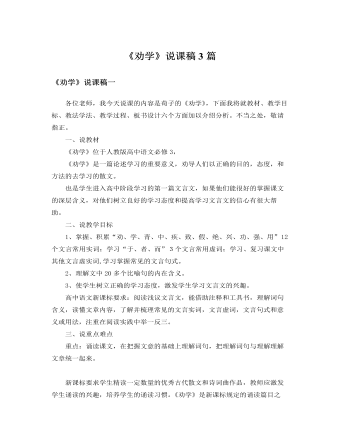
人教版高中语文必修3《劝学》说课稿3篇
《劝学》是普通高中课程标准试验教科书语文必修三第三单元的重点篇目,该文集中反映著名思想家荀子在学习问题上的观点和精彩斐然的论证艺术。该单元所选课文都是古代的议论性散文。通过本单元的学习在于让学生感受我国传统文化的精神,掌握基础的文言语法知识,学习如何清晰有力的表达自己的思想和见解。本文安排在单元的第一篇,如何指导学生学好这篇课文,是实现“授之以渔”,树立学生学好文言文的信心,掌握文言学习方法的关键。根据新课标倡导从“知识与能力”、“过程与方法”、“情感态度与价值观”三方面出发设计课程目标的要求和高一的学生对于文言文的知识还在积累的阶段,应该注重基础知识的积累和一定量的诵读的实际情况。我拟确定以下教学目标:1,了解荀子论述学习的思想,明确学习要靠积累、坚持不懈、专心致志的道理。2,掌握积累文言实词、虚词,活用、古今异议等现象和固定句式。
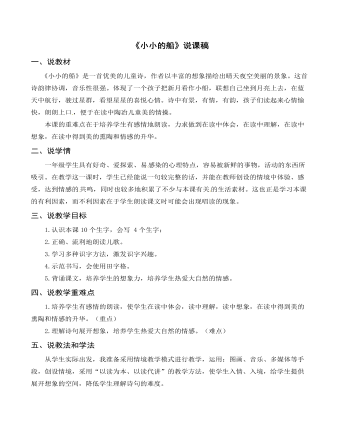
部编人教版一年级上册《小小的船》说课稿
(2)综合运用图画、语言、音乐,再创情境。(教师描述)如果现在是夜晚,我们一起坐在院子里,抬头看天空,蓝天上有星星,有月亮。这弯弯的月亮,它多像一艘小船呀!(播放背景音乐)现在请大家听着音乐 轻轻摆,慢慢地闭上眼睛。想着,想着,你是不是坐在月亮上了?是不是飞上蓝天了?(此时学生会情不自禁说自己已经飞上蓝天,已经坐在月亮上了。)当学生睁开眼睛,(师播放课件)哈,小朋 友现在我们已经飞上天了,已经坐在小船里了,让我们在月亮上愉快地唱起《小小的船》(播放儿童歌曲《小小的船》),伴随着歌声的响起,学生就会进入美妙的境界。教师随即出示句式:我看见了____________________________________。引导学 生说出:宇宙飞船上天,航天飞机登上月球等。接着再用“蓝蓝的天”进行说话训练。例如蓝蓝的天上有什么?我在蓝蓝的天上干什么?不难看出,在理解重点句子时,根据创设的情境,让学生充分展开想象的翅膀,学生往往为此而兴奋不已,学生情绪为之高涨,进入一个高潮。此举极大地丰富了课文内容,学生的学就乐在其中,悟也在其中。

(新)部编人教版四年级上册《风筝》说课稿
六、说教学流程良好的教学设想必须通过教学实践来完成的,本课我预设两课时完成:第一课时:学习生字,初读课文,感知课文的主要内容,初步体会“我们”心情的变化。第二课时:感悟课文,体会“我们”“做风筝、放风筝、找风筝”时的心情变化,感悟童真童趣。我本次说课的内容是第二课时的教学。(一)复习导入1.听写词语:风筝 蝴蝶 拔几根 幸福 托着 垂头丧气 半圈树梢 歇一歇 千呼万唤 踪影 磨坊2. 这课文写出了作者童年做风筝放风筝时的快乐的情景。这节课让我们细细体会其中的快乐。(板书:风筝)(设计理念:由回忆放风筝的情景,引入课题,既锻炼了学生的表达能力,又勾起了他们美好的回忆,再次感受放风筝给他们带来的乐趣。让学生在已有生活经验基础上构建知识,使学生在不知不觉中感悟,培养学生在面对新知时,能主动寻找其现实背景的能力,激发了学生学习的积极性。)
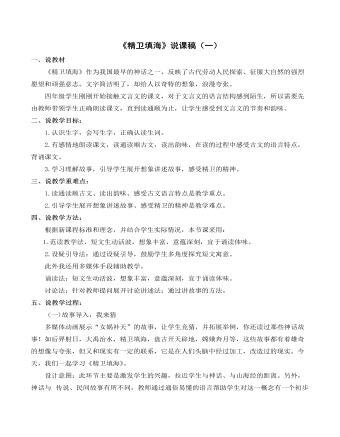
(新)部编人教版四年级上册《精卫填海》说课稿(一)
四、说教学方法: 根据新课程标准和理念,并结合学生实际情况,本节课采用: 1.范读教学法,短文生动活波,想象丰富,意蕴深刻,宜于诵读体味。2.设疑引导法:通过设疑引导,鼓励学生多角度探究短文寓意。此外我还用多媒体手段辅助教学。诵读法:短文生动活波,想象丰富,意蕴深刻,宜于诵读体味。讨论法:针对教师提问展开讨论讲述法:通过讲故事的方法。五、说教学过程:(一)故事导入,我来猜多媒体动画展示“女娲补天”的故事,让学生竞猜,并拓展举例,你还读过那些神话故事!如后羿射日,大禹治水,精卫填海,盘古开天辟地,嫦娥奔月等,这些故事都有着雄奇的想像与夸张,但又和现实有一定的联系,它是在人们头脑中经过加工,改造过的现实。今天,我们一起学习《精卫填海》。 设计意图:此环节主要是激发学生的兴趣,拉近学生与神话、与山海经的距离。另外,神话与 传说、民间故事有所不同,教师通过通俗易懂的语言帮助学生对这一概念有一个初步的认识,再自然引出课题。
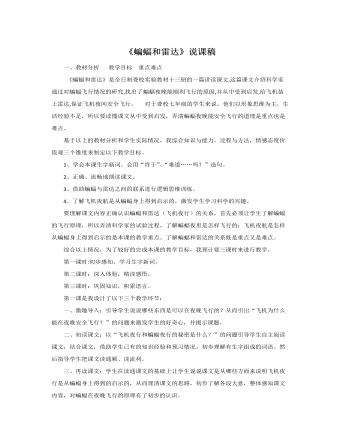
(新)部编人教版四年级上册《 蝙蝠和雷达》说课稿
一、激趣导入:引导学生说说哪些东西是可以在夜晚飞行的?从而引出“飞机为什么能在夜晚安全飞行?”的问题来激发学生的好奇心,并揭示课题。二、初读课文:以“飞机夜行和蝙蝠夜行的秘密是什么?”的问题引导学生自主阅读课文,结合课文,借助学生已有的知识经验和预习情况,初步理解有生字组成的词语。然后指导学生把课文读通顺、读流利。三、再读课文:学生在读通课文的基础上让学生说说课文是从哪些方面来说明飞机夜行是从蝙蝠身上得到的启示的,从而理清课文的思路,初步了解各段大意,整体感知课文内容,对蝙蝠在夜晚飞行的原理有了初步的认识。接下来我重点讲讲第二课时的教学设计。这一课的 教学中,我将以设疑悬疑──悟疑解疑──创造性思维训练,这种教学思路引导下,使学生充分发挥自己的主体作用,学生的积极性、主动性得到了充分的施展。学生不仅读懂了课文,认识也逐步加深。通过以下几个教学环节来完成教学任务。
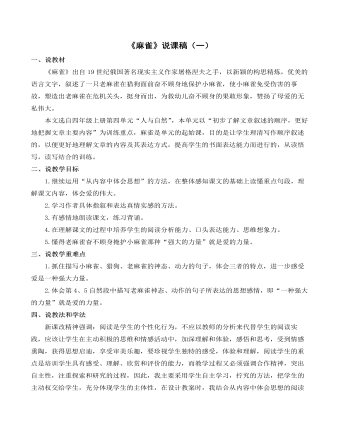
(新)部编人教版四年级上册《麻雀》说课稿(一)
五、说教学过程 (一)激发兴趣,自读自悟 《语文课程标准》指出:语文教学应激发学生的学习兴趣,注重培养学生自主学习的意识和习惯。所以我首先采用情境教学法,范读课文1—3自然段,把学生带入找猎归途的情境之中,拉近学生与文本、作者之间的距离,使学生在心底升腾起对小麻雀的怜惜之情,这时,我忙问一句“此时,你最想知道什么?”在老师的引导下,学生的兴趣就会集中到探讨“接下来会发生怎样的故事?这个故事告诉我们什么?这两个问题上来了,这时,我抛给学生一个问题,请同学们轻声自由朗读4—7自然段,画出让你感动的语句,抓住这些重点问句,有感情地去读,设身处境地地去想,在感受最深的问句旁边做上批注,在不懂的地方做上记号。
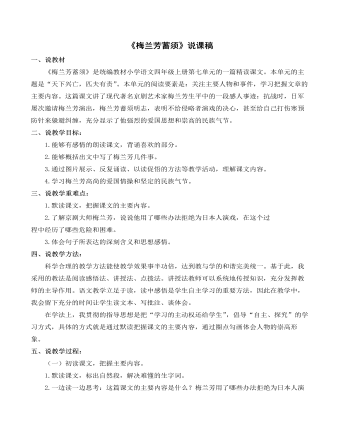
(新)部编人教版四年级上册《梅兰芳蓄须》说课稿
三、说教学重难点:1.默读课文,把握课文的主要内容。2.了解京剧大师梅兰芳,说说他用了哪些办法拒绝为日本人演戏,在这个过程中经历了哪些危险和困难。3.体会句子所表达的深刻含义和思想感情。四、说教学方法: 科学合理的教学方法能使教学效果事半功倍,达到教与学的和谐完美统一。基于此,我采用的教法是阅读感悟法、讲授法、点拨法。讲授法教师可以系统地传授知识,充分发挥教师的主导作用。语文教学立足于读,读中感悟是学生自主学习的重要方法,因此在教学中,我会留下充分的时间让学生读文本、写批注、谈体会。 在学法上,我贯彻的指导思想是把“学习的主动权还给学生”,倡导“自主、探究”的学习方式,具体的方式就是通过默读把握课文的主要内容,通过圈点勾画体会人物的崇高形象。
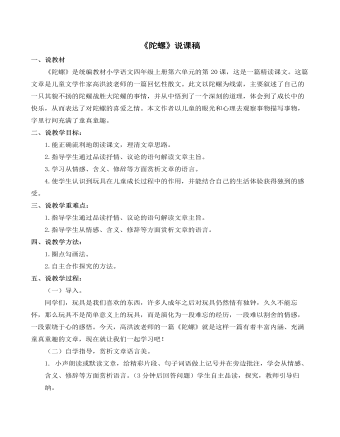
(新)部编人教版四年级上册《陀螺》说课稿
2.初批交流习方法我先结合作者的第一处心情描写指导学生在画批中让语言更精炼。起初作者的心情是怎样的呢?(出示教学片段) [设计意图:在课堂教学中我敏锐捕捉到学生在交流反馈中语言啰嗦,表现为:学生批注的是句子;摘抄了文中相关内容;在批注中分析了自己思考的过程。针对这个实际学情,我在学生的初批成果上进行改批指导,像刚才视频中那样引导学生批注时应该写自己的理解而不是摘抄文中内容;根据自学提示的要求批注人物心情;批注更应精炼,留下的痕迹应是最触动读者心弦的内容,让学生清晰地看到语言由繁到简的过程。]
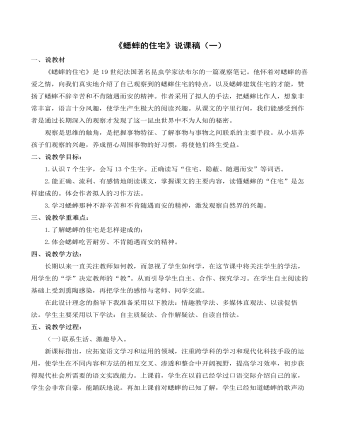
(新)部编人教版四年级上册《蟋蟀的住宅》说课稿(一)
二、说教学目标: 1.认识7个生字,会写13个生字。正确读写“住宅、隐蔽、随遇而安”等词语。2.能正确、流利、有感情地朗读课文,掌握课文的主要内容,读懂蟋蟀的“住宅”是怎样建成的。体会作者拟人的习作方法。 3.学习蟋蟀那种不辞辛苦和不肯随遇而安的精神,激发观察自然界的兴趣。三、说教学重难点:1.了解蟋蟀的住宅是怎样建成的;2.体会蟋蟀吃苦耐劳、不肯随遇而安的精神。四、说教学方法: 长期以来一直关注教师如何教,而忽视了学生如何学,在这节课中将关注学生的学法,用学生的“学”决定教师的“教”。从而引导学生自主、合作、探究学习。在学生自主阅读的基础上受到熏陶感染,再把学生的感悟与老师、同学交流。 在此设计理念的指导下我准备采用以下教法:情趣教学法、多媒体直观法、以读促悟法。学生主要采用以下学法:自主质疑法、合作解疑法、自读自悟法。

